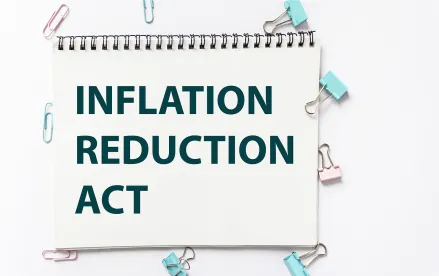On August 29, 2023,[1] the IRS and Treasury Department released proposed regulations (the Proposed Regulations) regarding the prevailing wage requirements (the Prevailing Wage Requirements) and the apprenticeship requirements (the Apprenticeship Requirements and, together with the Prevailing Wage Requirements, the Labor Requirements) under the Internal Revenue Code (the Code), as amended by the Inflation Reduction Act of 2022 (the IRA). Taxpayers generally must satisfy the Labor Requirements in order to receive the full amount of certain energy transition tax credits (each, an Increased Credit) for eligible facilities, properties, projects, or equipment (each, a Project).
The following is a summary of significant provisions in the Proposed Regulations.
General Guidance
-
Incorporation of Davis-Bacon Act. Consistent with Notice 2022-61 (the Notice),[2] the Proposed Regulations rely on various definitions and guidance under the Davis-Bacon Act (the DBA).[3] The preamble to the Proposed Regulations (the Preamble) explains that the Proposed Regulations incorporate elements of the DBA only to the extent relevant and consistent with sound tax administration. For example, the Proposed Regulations incorporate the definitions of “laborer” and “mechanic,” “construction, alteration, or repair,” “wages,” and “employed” from the DBA and rely on substantive DBA guidance with respect to wage determinations and recordkeeping, in each case, with appropriate changes for the particular context of the Labor Requirements.
-
Implications for credit transfers. In addition to taxpayers that claim an Increased Credit on their own federal income tax returns, the Proposed Regulations apply to taxpayers that elect to transfer an Increased Credit pursuant to Section 6418 of the Code.[4] Specifically, a credit transferor is responsible for satisfying the Labor Requirements, making any Correction Payment, Underpayment Penalty Payment, or Labor Hour Penalty Payment (each as defined below), and complying with the recordkeeping requirements with respect to a transferred Increased Credit.
Prevailing Wage Requirement Guidance
-
Generally. The IRA provides that, in order to receive an Increased Credit with respect to a Project, a taxpayer must ensure that laborers and mechanics employed by the taxpayer (or any contractor or subcontractor) in the construction, alteration, or repair of the Project be paid wages at least equal to the prevailing rate determined by the US Department of Labor (the DOL) in accordance with the DBA.
-
General wage determinations. The Proposed Regulations confirm that taxpayers may rely on the general wage determinations published on www.sam.gov, which provide prevailing wage and bona fide fringe benefit rates for laborers and mechanics for the various classifications of work performed with respect to specified types of construction in certain geographic areas.
-
Supplemental wage determinations and additional classifications. The Proposed Regulations provide special procedures in the event the DOL has not issued a general wage determination for the relevant geographical area or type of construction or, if such a general wage determination has been issued, the determination does not provide wages for the relevant labor classifications. In such case, the taxpayer must request a supplemental wage determination or request a prevailing wage rate for an additional labor classification from the DOL, in each case, by submitting the request and certain supporting materials directly to the Wage and Hour Division of the DOL. A supplemental wage determination or prevailing wage rate for an additional labor classification provided to the taxpayer after the construction, alteration, or repair of a Project begins would apply retroactively to the start of the relevant work. The Proposed Regulations also provide a procedure for taxpayers to appeal a DOL decision, which was absent from the Notice.
-
Obligations to update prevailing wage rates. The Proposed Regulations require taxpayers to use the general wage determination in effect when the construction of a Project begins, without any obligation to update the prevailing wage rates if the DOL publishes a new general wage determination thereafter. A new general wage determination, however, would be required if an engineering, procurement, and construction (or similar) contract is amended to (1) include additional, substantial construction, alteration, or repair work not within the original scope of work or (2) require work to be performed for an additional time period. In addition, taxpayers generally are required to update the applicable wage rates with respect to any alteration or repair of a Project that begins after placement into service.
-
Geographic areas. The Proposed Regulations provide that a taxpayer must use the applicable wage determination for the work performed in each geographic area where the construction, alteration, or repair of a Project occurs. For this purpose, a “geographic area” is defined as the county, independent city, or other civil subdivision of the state in which the Project is located.
-
Multiple construction sites. A Project is treated as located in a geographic area (or areas) that includes the primary construction site. A Project also is treated as located in a geographic area (or areas) including an additional site, but only if (1) a significant portion of the Project is constructed, altered, or repaired at the additional site; (2) the construction at the additional site is for the specific use of the taxpayer’s Project rather than reflecting manufacture or construction of a product available for the general public; and (3) the additional site is established specifically for, or is dedicated exclusively to, the construction, alteration, or repair of the Project for at least a period of weeks.
-
Support sites. A Project is treated as located in a geographic area (or areas) that includes a support site that is established specifically for, or is dedicated exclusively to, the construction, alteration, or repair of the Project and is adjacent (or virtually adjacent) to a primary or secondary construction site. Examples of support sites include job headquarters, batch plants, and tool yards.
-
Offshore Projects. In the case of an offshore Project, the taxpayer may rely on the general wage determination for the relevant category of construction that is applicable in the geographic area closest to the area in which the Project will be located.
-
-
Routine maintenance. The Proposed Regulations confirm that the Prevailing Wage Requirements do not apply to routine operations and maintenance (O&M) work, provided that the work is ordinary, regular, and designed to maintain existing functionality of the Project. By contrast, the Prevailing Wage Requirements apply to isolated and infrequent repairs of a Project to restore specific functionality or adapt the Project for a different or improved use.
-
Rate of pay for apprentices. A taxpayer (or any contractor or subcontractor) is permitted to pay apprentices (or individuals in the first 90 days of probationary employment as an apprentice) below the prevailing wage rate, provided that the apprentice (or individual) is participating in a registered apprentice program. The taxpayer, however, is required to pay such an apprentice (or individual) the full prevailing rate if the DOL’s office of apprenticeship or state equivalent withdraws its approval of the program.
-
Correction and penalty payments. The IRA permits taxpayers to cure a failure to comply with the Prevailing Wage Requirements by (1) paying the applicable laborer or mechanic the amount of underpaid wages, plus interest at the penalty rate (Correction Payments) and (2) paying a $5,000 penalty to the Treasury for each underpaid laborer and mechanic (Underpayment Penalty Payment). If such a failure is found to be due to intentional disregard, the amount of each Correction Payment is tripled and the amount of each Underpayment Penalty Payment is doubled.
-
Timing of payments. The Proposed Regulations provide that a taxpayer is not obligated to make Correction Payments or Underpayment Penalty Payments until the taxpayer files a federal income tax return claiming the Increased Credit. Taxpayers, however, are permitted to make Correction Payments to laborers and mechanics at any time after the initial payments are made and in advance of the filing of such tax return in order to limit the amount of additional interest included in the applicable Correction Payments. By contrast, the earliest time that a taxpayer can make an Underpayment Penalty Payment is at the time of filing such tax return.
-
Missing laborers and mechanics. The Proposed Regulations do not provide an exception to the requirement to make Correction Payments to laborers and mechanics that cannot be located. The Preamble, however, requests comments on this topic, which indicates that the IRS and Treasury Department are still considering the issue.
-
Intentional disregard. The Proposed Regulations define “intentional disregard” as the knowing or willful failure to satisfy the Prevailing Wage Requirements, which is determined based on all the relevant facts and circumstances. In addition, the Proposed Regulations create a rebuttable presumption against a finding of intentional disregard if the taxpayer makes any Correction Payments and Underpayment Penalty Payments before receiving a notice of a tax return examination.
-
-
Penalty waiver. The Proposed Regulations provide a limited penalty waiver in the case of certain de minimis failures to comply with the Prevailing Wage Requirements. An Underpayment Penalty Payment will be waived for a calendar year if (1) the laborer or mechanic is paid below the prevailing rate for 10 percent or less of all pay periods in the calendar year (or part thereof) during which the laborer or mechanic worked on the construction, alteration, or repair of the Project or (2) the difference between the amount the laborer or mechanic was paid and the amount required to be paid under the Prevailing Wage Requirements for the calendar year (or part thereof) is not greater than 2.5 percent of the amount required to be paid. In order to qualify for the waiver, the taxpayer must make the Correction Payment by the earlier of 30 days after discovery of the failure and the date on which the taxpayer files the federal income tax return claiming the Increased Credit.
-
Project labor agreements. The Proposed Regulations provide that a taxpayer is not required to make an Underpayment Penalty Payment with respect to a laborer or mechanic employed under a pre-hire collective bargaining agreement that establishes the terms and conditions of employment for a specific Project (and satisfies certain other conditions), but only if the taxpayer makes any Correction Payments on or before the date the taxpayer files the federal income tax return claiming the Increased Credit.
Apprenticeship Requirement Guidance
-
Generally. The Proposed Regulations confirm that a taxpayer must comply with the Labor Hours Requirement, the Ratio Requirement, and the Participation Requirement (each as defined below) with respect to a Project in order to satisfy the Apprenticeship Requirements. A noncompliant taxpayer, however, will be deemed to have satisfied the Apprenticeship Requirements if it has made a good faith effort to do so (the Good Faith Effort Exception).
-
Labor Hours Requirement. A taxpayer must ensure that a statutory percentage of the total labor hours of construction, alteration, or repair work with respect to a Project is performed by qualified apprentices (the Labor Hours Requirement). The statutory percentage is 10 percent for Projects that began construction before 2023, 12.5 percent for Projects that begin construction in 2023, and 15 percent for Projects that begin construction during or after 2024.
-
Ratio Requirement. A taxpayer must ensure that a Project complies with any apprentice-to-journey worker ratio required by the DOL or state equivalent (the Ratio Requirement). Notably, the Proposed Regulations provide that labor hours worked by apprentices on a day when the applicable ratio is not met are not counted as qualified apprentice labor hours for purposes of calculating the applicable percentage under the Labor Hours Requirement.
-
Participation Requirement. A taxpayer (and any contractor or subcontractor) that employs four or more individuals to perform construction, alterations, or repairs with respect to a Project must employ one or more qualified apprentices for the relevant work.
-
-
The Good Faith Effort Exception. A taxpayer is eligible for the Good Faith Effort Exception if the taxpayer has requested qualified apprentices from a registered apprenticeship program and such request has been denied, provided that the request is denied for a reason other than the taxpayer’s (or any contractor’s or subcontractor’s) noncompliance with program requirements, or the program does not respond to the taxpayer within five business days after receiving a request.
-
Scope of written request. The Proposed Regulations provide that, to qualify for the Good Faith Effort Exception, a taxpayer (or any contractor or subcontractor) must make a written request to at least one registered apprenticeship program that (1) has a geographic area of operation that includes the location of the Project or that can reasonably be expected to provide apprentices to the location of the Project; (2) trains apprentices in the occupation(s) needed by the taxpayer, contractors, or subcontractors performing construction, alteration, or repair with respect to the Project; and (3) has a usual and customary business practice of entering into agreements with employers for the placement of apprentices in the occupation for which they are training.
-
Denials and nonresponsive programs. The Proposed Regulations provide that a taxpayer may rely on the Good Faith Effort Exception with respect to a denial, or lack of response, from a registered apprenticeship program for 120 days after the date on which the request was submitted. Thereafter, a taxpayer would be required to submit an additional request to the program if it seeks to continue to qualify for the Good Faith Effort Exception.
-
-
Penalty payments. The IRA permits taxpayers to cure a failure to comply with the Labor Hours Requirement or the Participation Requirement by paying a penalty to the Treasury equal to $50 for each labor hour for which either requirement is not met (Labor Hour Penalty Payments). If such a failure is found to be due to intentional disregard, the amount of each Labor Hour Penalty Payment is multiplied by 10.
-
Intentional disregard. Similar to the Prevailing Wage Requirements, the Proposed Regulations define “intentional disregard” as the knowing or willful failure to satisfy the Apprenticeship Requirements and create a rebuttable presumption of no intentional disregard if the taxpayer makes any Labor Hour Penalty Payments before receiving a notice of a tax return examination.
Recordkeeping
-
Consistent with the Notice, the Proposed Regulations confirm that the recordkeeping standards of Section 6001 of the Code and the associated Treasury Regulations apply for purposes of the Labor Requirements. At a minimum, a taxpayer claiming or transferring an Increased Credit must retain payroll records for each laborer, mechanic, or qualified apprentice employed by the taxpayer (or any contractor or subcontractor) in the construction, alteration, or repair of the applicable Project.
-
In addition, such a taxpayer must comply with certain additional recordkeeping requirements that are specific to the Prevailing Wage Requirements and the Apprenticeship Requirements.
Proposed Effective Date
-
The Proposed Regulations are proposed to apply to Projects placed in service in taxable years ending after the date these regulations are published as final regulations in the Federal Register and the construction or installation of which begins after the date the Proposed Regulations are published as final regulations in the Federal Register.
-
Taxpayers may rely on the Proposed Regulations with respect to construction or installation of a Project beginning on or after January 29, 2023, and on or before the date the Proposed Regulations are published as final regulations in the Federal Register. From and after October 30, 2023, however, any taxpayer that chooses to do so must follow the Proposed Regulations in their entirety and in a consistent manner.
Looking Ahead
-
The IRS and Treasury Department will accept public comments to the Proposed Regulations until October 30, 2023.
-
A public hearing on the Proposed Regulations is scheduled for November 21, 2023.
[1] On the same day, the IRS and Treasury Department released Frequently Asked Questions and Publication 5855.
[2] We discussed the Notice in a previous client alert.
[3] The DOL recently released a final rule under the DBA.
[4] We discussed the proposed regulations under Section 6418 in a recent client alert.




 />i
/>i
